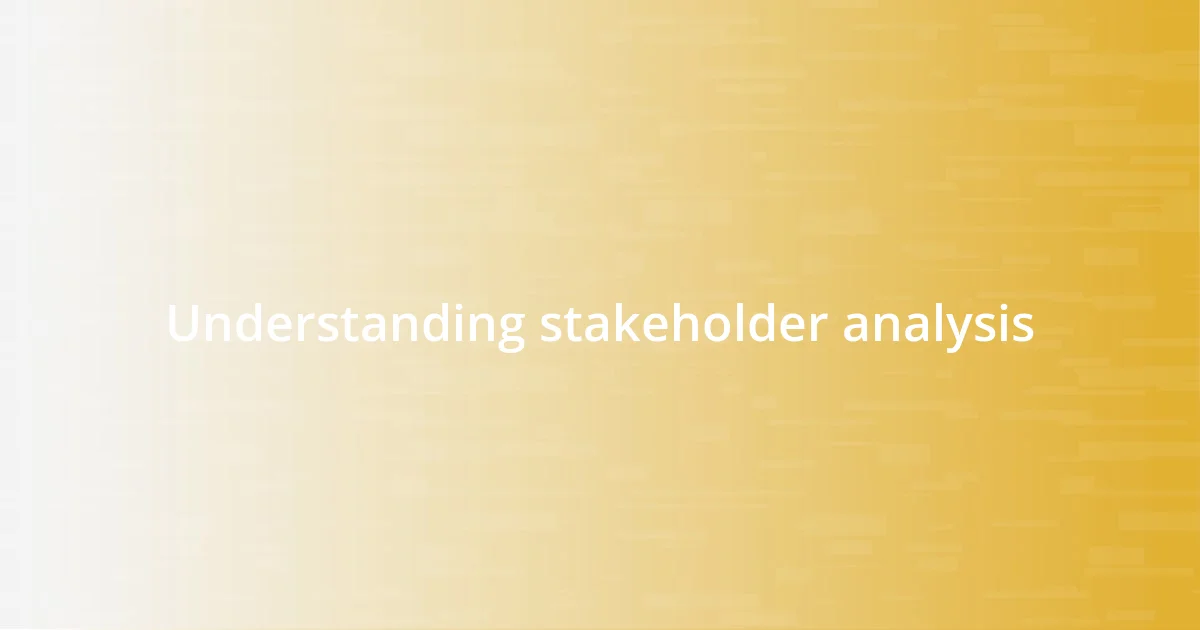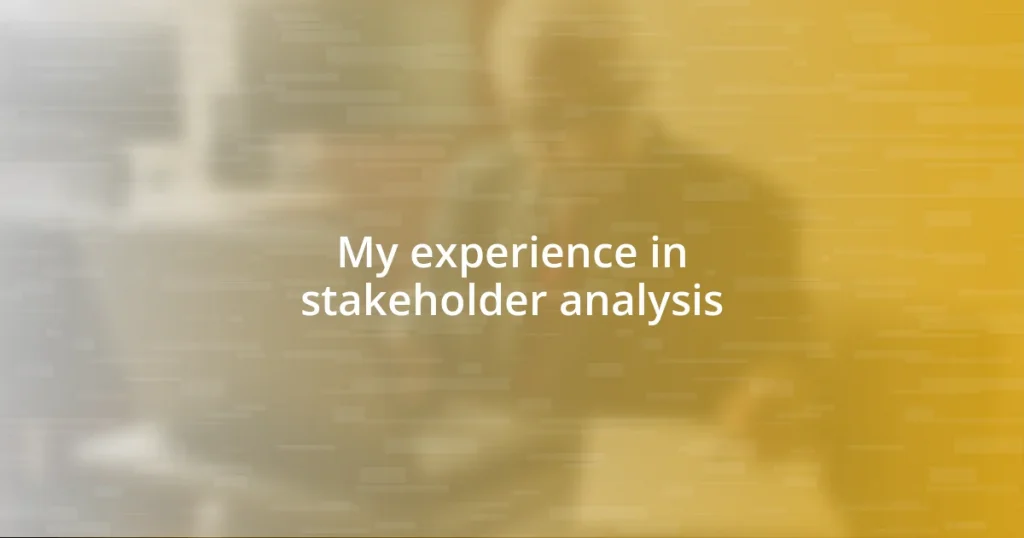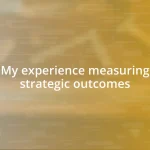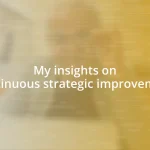Key takeaways:
- Effective stakeholder analysis involves understanding diverse interests and emotions, enabling better project alignment and relationship building.
- Identifying key stakeholders includes assessing their power, interest, relationships, investment, and communication needs for streamlined engagement.
- Evaluating stakeholder engagement outcomes through both quantitative and qualitative feedback fosters a culture of collaboration and continuous improvement.

Understanding stakeholder analysis
When I first delved into stakeholder analysis, I found it fascinating how deeply it influences project outcomes. It’s not just a fancy term; it’s about recognizing who has skin in the game—those individuals or groups who can affect or be affected by a project. I often ask myself, “How can I truly understand what drives these stakeholders?” The answer lies in effective communication and genuine relationship building.
One key revelation for me was how diverse stakeholder interests can be. I remember a project where stakeholders had conflicting priorities, making it challenging to align our objectives. This experience taught me the importance of mapping out each stakeholder’s influence and interest levels. Have you ever faced a similar challenge? I realized early on that, by doing so, I could focus my efforts on engaging those who mattered most, ultimately steering the project toward success.
Emotions play a significant role in stakeholder analysis; understanding what drives people is essential. During one project, a key stakeholder felt undervalued, which led to friction. This taught me the value of empathy—actively listening to their concerns and addressing their needs made a world of difference. It’s not just about the project; it’s about people. Isn’t that a powerful insight?

Identifying key stakeholders
Identifying key stakeholders requires a careful analysis of various individuals and groups related to your project. Reflecting on my experiences, I’ve learned that it’s crucial to consider who holds power, who has interest, and who may be impacted. I recall a specific instance where a minor town hall meeting revealed a passionate community group that I hadn’t initially thought of. Their insights proved invaluable, demonstrating that sometimes the most significant stakeholders aren’t the loudest voices in the room.
To help streamline this process, here’s a quick checklist I often refer to when identifying key stakeholders:
- Power: Who can influence the project or its outcomes?
- Interest: Who will be affected by the project’s success or failure?
- Relationship: What is the nature of each stakeholder’s connection to the project?
- Investment: Who has a financial or emotional stake in the project?
- Communication Needs: How often and in what manner should I communicate with each stakeholder?
This list not only clarifies priorities but also enhances my ability to engage with those who truly matter.

Assessing stakeholder interests
Assessing stakeholder interests is a delicate process that requires keen observation and proactive engagement. During a significant project, I developed a stakeholder matrix to visualize various interests and influence levels. This method allowed me to pinpoint not just the obvious stakeholders but also hidden voices whose interests could make or break the project. It’s fascinating how understanding these diverse motivations can create a deeper connection and pave the way for smoother collaboration.
I vividly remember a project where I overlooked a key stakeholder’s concerns because I didn’t take their unique interests into account. Once I recognized their need for community involvement and acknowledgment, the dynamic shifted dramatically. Suddenly, our meetings became more productive as I learned to actively integrate their feedback, fostering a sense of ownership. Isn’t it intriguing how acknowledging interests can transform relationships?
Emotions are intertwined with interests; we mustn’t forget that. I once worked closely with a stakeholder who was deeply invested in a project’s environmental impact. Their passion added urgency to our discussions, prompting us to rethink our approach. This taught me that when we assess not just interests but emotional stakes, we can cultivate stronger alliances—and ultimately, more successful outcomes.
| Stakeholder Interests | Examples |
|---|---|
| Direct Interest | Stakeholders who have a strong impact on project outcomes, such as executive leadership or funding bodies. |
| Indirect Interest | Individuals or groups, like community members or advocacy organizations, whose lives are affected by the project. |

Analyzing stakeholder influence
Analyzing stakeholder influence can be quite revealing. For me, a real eye-opener was during a project overhaul when I decided to map out the influence of various stakeholders on a large-scale initiative. By doing this, I recognized that an individual, who I initially considered a peripheral player, had a surprisingly significant sway over local government decisions. This realization reshaped our strategy completely. I often wonder: how many other influential voices have we overlooked in our projects?
It’s not just about identifying who has power; it’s also about understanding how they wield it. In one instance, I engaged a stakeholder who, while not in a formal leadership position, had the trust and respect of the community. His endorsement turned the tide for our project’s acceptance. Reflecting on that, I’m convinced that fostering relationships and truly listening to those informal influencers can be a game changer. Isn’t it fascinating how influence often operates below the radar?
In my experience, understanding the nuances of stakeholder influence is essential for success. I recall a situation where a stakeholder, initially resistant to our plans, became an unexpected ally after I took the time to understand their hesitations. This shift happened simply through open dialogue and active listening. It reinforced to me that influence isn’t just about authority; it’s built through connection and trust. How do you approach discovering these layers of influence in your own projects?

Developing communication strategies
Crafting effective communication strategies is like weaving a delicate fabric; every thread represents a different stakeholder’s voice. I remember a project where we faced significant pushback due to miscommunication. By implementing regular updates and feedback loops, we turned confusion into clarity. It was remarkable how simple, ongoing conversations shaped the narrative and helped everyone feel included in the process.
I’ve found that tailoring messages to fit the audience is crucial. In one case, I had to communicate sensitive budgetary decisions to both the finance team and project volunteers. Using jargon-heavy language with the volunteers only caused frustration. Instead, I switched to relatable analogies that kept everyone on the same page. Have you ever noticed how the right words can create an instant connection?
Another aspect to consider is timing. I learned this lesson the hard way when I presented a major change during a tense meeting. The response was tepid at best; emotions were running high, and my efforts felt wasted. Reflecting on that moment, I realized that context matters immensely. Ensuring a calm, receptive environment for discussions can dramatically shift outcomes. How do you gauge the right moment to share vital updates?

Engaging stakeholders effectively
Engaging stakeholders effectively requires more than just good communication; it’s about creating a genuine connection. I remember a time when I organized a casual coffee chat with a group of stakeholders who were initially skeptical of our project. This informal setting allowed them to share their concerns openly, and I was able to address their doubts in real time. Have you ever experienced how a relaxed atmosphere can transform tough conversations?
Building trust doesn’t just happen overnight; it takes consistent effort and authenticity. In a past project, I made it a point to follow up personally after meetings. This simple gesture showed my stakeholders that their opinions mattered. I’ve often reflected on how little things like a handwritten note or a quick call can reinforce relationships. Have you thought about little ways to show your stakeholders they are valued?
Lastly, I can’t stress enough the importance of being adaptable during stakeholder engagement. There was a moment when unforeseen challenges arose, causing a key stakeholder to change their stance entirely. Instead of pushing my agenda, I listened to their revised concerns and adjusted our approach accordingly. That shift not only salvaged the relationship but also created a partnership that was more resilient to challenges. When faced with your own obstacles, how do you adapt your engagement strategies to keep stakeholders on board?

Evaluating stakeholder engagement outcomes
Evaluating stakeholder engagement outcomes is essential for understanding the effectiveness of our efforts. I distinctly remember wrapping up a project where we conducted an anonymous survey to gauge stakeholder sentiments. The responses were mixed, which surprised me, but it highlighted areas we had overlooked. This experience taught me that collecting diverse feedback can provide a clearer picture of where we stand. Have you ever been taken aback by what you didn’t see coming?
Quantitative data, like attendance numbers at meetings or participation rates in surveys, offers one piece of the puzzle. Yet, I’ve found qualitative insights to be just as valuable. For instance, after a particularly challenging project kickoff, I initiated one-on-one conversations to delve deeper into individual concerns. Those candid discussions revealed not just dissatisfaction, but also underlying motivations that shaped their perceptions. It’s fascinating how a few heartfelt conversations can enrich our understanding, isn’t it?
Ultimately, I believe that evaluating outcomes is an ongoing journey, not a final destination. After one project, we held a debriefing session that included stakeholders from various levels. As we reviewed our successes and shortcomings, I observed a genuine willingness for collaboration in our discussions. This experience reinforced my belief that creating a culture of open evaluation can transform stakeholders into proactive partners. When was the last time you turned a reflection session into a stepping stone for future growth?















